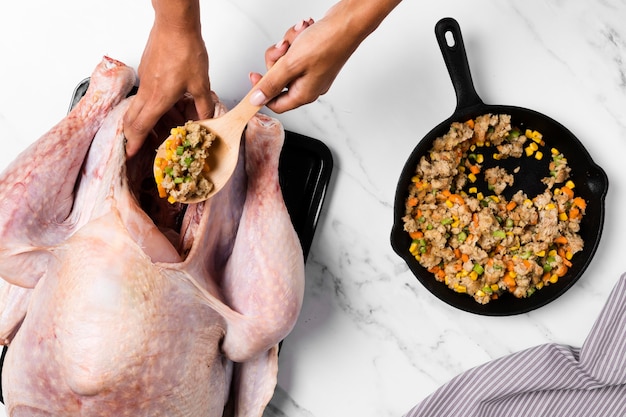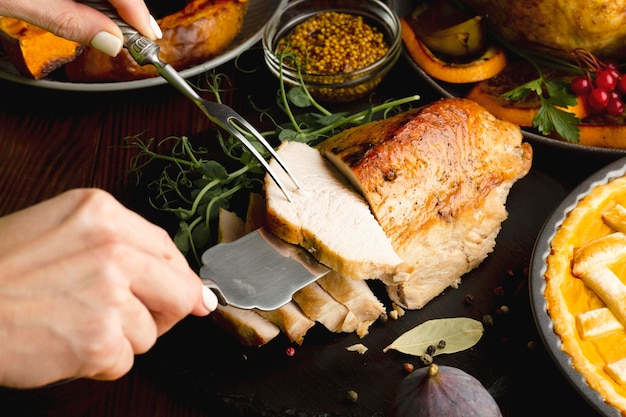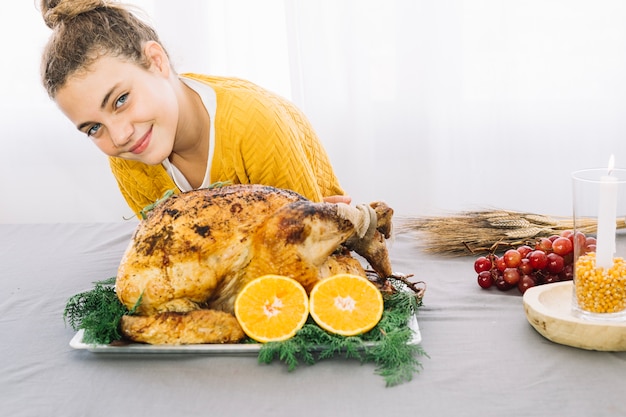Let's talk turkey legs, specifically oven roasted turkey legs. Now, you might be thinking, "Turkey legs? Isn't that just for Christmas or Thanksgiving?" But, my friends, I'm here to tell you, those delicious drumsticks are so much more than just holiday fare. They're versatile, flavorful, and perfect for any occasion. A weeknight dinner? You bet. A weekend feast? Absolutely. A picnic? Why not! They're easy to make, and with a few simple tips and tricks, you can achieve juicy, tender, and flavorful results that will have everyone clamoring for seconds.
I've been cooking turkey legs for years, and trust me, I've learned a thing or two. I've had my share of dry, overcooked legs, and I've also had some that were so juicy and tender they practically fell off the bone. So, today, I'm going to share my secrets and guide you towards turkey leg perfection. Let's dive in!
(Part 1) Choosing the Right Turkey Legs: A Foundation for Flavor

Size Matters: Finding the Perfect Drumstick
When it comes to turkey legs, size matters. You want those plump, meaty drumsticks that will give you a satisfying meal. Now, you can find them individually or in packages. I usually go for packages, mainly because it’s often more cost-effective, and you get a variety of sizes to choose from.
At the butcher, I look for legs that are at least 1-1.5 pounds each. That's a good size for a satisfying serving, but if you're feeding a crowd, go bigger, no judgment here! It’s all about finding the right size for your needs.
Fresh vs. Frozen: A Matter of Preference
You’ll also need to decide: fresh or frozen? Personally, I prefer fresh turkey legs because they tend to have a more robust flavor. But, if you're on a tight budget or don't have easy access to fresh legs, frozen ones are a great alternative. Just make sure to thaw them thoroughly before cooking. We'll talk more about thawing later.
(Part 2) Prepping Your Turkey Legs for Roasting: A Symphony of Flavor

The Magic of Brining: Unveiling Tenderness
Okay, you've got your turkey legs, now it's time to prep them for roasting. And this is where the real magic happens. I'm a firm believer in brining turkey legs. Why? Because brining helps to lock in moisture and creates incredibly tender and juicy results. It's like giving them a little spa treatment before they hit the oven.
Brining is a simple process of soaking the turkey legs in a salt water solution. This allows the salt to penetrate the meat, drawing out moisture and making it unbelievably tender. There are countless brining recipes online, but I like to keep things simple. My go-to brine is a mix of salt, water, and a touch of sugar. The sugar balances out the saltiness and adds a delightful sweetness to the final product. I usually brine for at least 4 hours, but overnight is even better. It's really about time and personal preference. I always say, experiment and find what works best for you!
Spatchcocking: A Time-Saving Trick
Now, if you're short on time or want to speed up the cooking process, there's a technique called spatchcocking. It essentially involves butterflying the turkey leg by removing the backbone. This flattens it out, allowing it to cook more evenly and faster. I'll be honest, I haven't tried spatchcocking turkey legs myself. I prefer the traditional method of roasting the whole leg, but I've heard great things about spatchcocking, so it's definitely worth exploring if you’re looking for a quicker option.
Seasoning Secrets: A Flavorful Embrace
Alright, you've brined or not brined (your choice!), and you're ready to season those turkey legs. This is where you can get creative and really make your dish shine. I keep it simple with high-quality salt, pepper, and some dried herbs like rosemary and thyme. But, you can also use paprika, garlic powder, onion powder, or even a bit of chili powder for some heat. The key is to season generously, both inside and out. Remember, you want the flavor to penetrate every nook and cranny of that delicious meat.
You can also try making a rub, which is basically a mixture of dry ingredients that you rub all over the turkey legs. My go-to rub is a mix of smoked paprika, garlic powder, onion powder, brown sugar, and a pinch of cayenne pepper. It gives the turkey legs a beautiful smoky flavor with a hint of sweetness and a little kick. It's a winner!
(Part 3) Getting Ready for Roasting: A Stage for Flavor

Preheating the Oven: A Critical First Step
Your turkey legs are prepped and ready for the oven. Now, it's time to get your oven ready. I usually preheat mine to 350°F (175°C), but you can adjust the temperature based on your oven and your preference. And remember, when you're dealing with poultry, it's crucial to use an oven thermometer to ensure your oven is at the right temperature. Trust me, it will make a difference in the final outcome of your turkey legs.
Choosing the Right roasting pan: A Culinary Canvas
Now, you need a good roasting pan. I have a few different sizes and styles that I use depending on the number of turkey legs I'm roasting. For a couple of legs, I might use a small baking sheet. But, for a larger batch, I opt for a bigger roasting pan with a rack. A rack is incredibly helpful because it allows air to circulate around the legs, promoting more even cooking.
Roasting with Vegetables: A Flavorful Ensemble
You can also roast your turkey legs with vegetables. It's a delicious and convenient way to create a complete meal. I love roasting my turkey legs with potatoes, carrots, and onions. Just toss them with a little olive oil, salt, and pepper, and spread them around the turkey legs. The vegetables will soak up all those delicious juices, making them incredibly flavorful.
I've even experimented with roasting turkey legs with apples and pears. The sweetness of the fruit really complements the savory flavor of the turkey. It's a unique twist, but definitely worth trying if you're looking for something different. You can get really creative and experiment with various vegetable combinations. The possibilities are endless!
(Part 4) Roasting Your Turkey Legs to Perfection: A Culinary Masterpiece
Determining Cooking Time: A Balancing Act
Okay, your turkey legs are ready for the oven! Now, here's the million-dollar question: how long do you cook them? Well, it depends on the size of your legs and how well-done you like them. Generally, I cook my turkey legs for about 1 hour and 15 minutes to 1 hour and 30 minutes at 350°F (175°C) for legs that are 1-1.5 pounds each. But, as I mentioned before, it's best to use a meat thermometer to ensure they're cooked through. You want the internal temperature to reach 165°F (74°C) for food safety.
Monitoring the Roasting Process: A Watchful Eye
While your turkey legs are roasting, keep a watchful eye on them. You want to make sure they're not drying out. If the skin starts to look too brown, you can cover them with foil to prevent burning. And if the juices start to pool at the bottom of the roasting pan, you can baste the legs with the juices. This adds moisture and flavor, giving the turkey legs a beautiful golden brown color.
Resting is Key: A Moment of Relaxation
Once your turkey legs are cooked through, it's essential to let them rest for at least 10 minutes before carving. This allows the juices to redistribute throughout the meat, making them even more tender and juicy.
Think of it as giving the turkey legs a chance to relax after their little oven adventure. And while they're resting, you can make a delicious gravy using the juices in the roasting pan. It's the perfect way to enhance the flavor of your meal and make the most of those flavorful juices.
(Part 5) Alternative Roasting Methods: Expanding Your Culinary Horizons
smoked turkey legs: A Smoky Symphony
While roasting in the oven is a classic method, if you're feeling adventurous, you can also try smoking your turkey legs. They emerge with an incredible smoky flavor that elevates the dish to a whole new level. You'll need a smoker, obviously, and some wood chips to add that smoky aroma. I usually use hickory or applewood chips for a nice, balanced flavor. You can experiment with different woods to find what you like best. Have fun with it!
Now, smoking turkey legs takes a bit longer than roasting in the oven. You'll need to smoke them for about 4-5 hours at a low temperature, around 225°F (107°C). Keep an eye on them and make sure they're not getting too dry. And remember, that meat thermometer is your best friend in these situations.
instant pot Turkey Legs: Quick and Convenient
For those who prefer speed and convenience, the Instant Pot is a fantastic option for cooking turkey legs. It's quick and easy, and the results are surprisingly good. Just put your turkey legs in the Instant Pot with some liquid, like chicken broth or water, and cook on high pressure for about 45 minutes to 1 hour. You'll get tender, juicy turkey legs in a fraction of the time. It's a lifesaver on busy weeknights!
(Part 6) Serving Your Oven Roasted Turkey Legs: A Culinary Presentation
Presenting the Feast: A Feast for the Eyes
Alright, your turkey legs are cooked, rested, and ready to be devoured. Now it's time to present your culinary masterpiece. I like to serve my turkey legs on a platter with some roasted vegetables. If you're feeling fancy, you can also add some fresh herbs for decoration. But don't forget the gravy! It's the perfect finishing touch.
side dish Options: A Symphony of Flavors
When it comes to side dishes, the possibilities are endless. You can go with classic choices like mashed potatoes, cornbread stuffing, or green bean casserole. Or, you can get creative with something a bit more unique, like quinoa salad, roasted brussels sprouts, or a fruit salad. It all depends on your preferences and the occasion.
(Part 7) Storage and Leftovers: Making the Most of Your Feast
Storing Leftover Turkey Legs: Preserving the Flavor
If you have leftovers, which is likely, don't worry! You can store them in the refrigerator for up to 4 days. Just make sure to cool them completely before storing them in an airtight container. You can also freeze leftover turkey legs for up to 2 months. Just thaw them in the refrigerator before reheating.
Reheating Options: Bringing Back the Flavor
When you're ready to reheat your turkey legs, you have a few options. You can reheat them in the oven, microwave, or even on the stovetop. I prefer to reheat them in the oven at a low temperature, about 300°F (150°C), for about 15-20 minutes. This helps to keep them moist and flavorful.
You can also create a delicious turkey leg sandwich or salad with leftover turkey meat. It's a great way to use up leftovers and create a new and exciting meal.
(Part 8) Tips and Tricks for Oven Roasted Turkey Legs: Master the Art
Here are some helpful tips and tricks I've picked up over the years to elevate your turkey leg game:
- Use a meat thermometer to ensure your turkey legs are cooked through to 165°F (74°C). This is crucial for food safety and ensures that your turkey legs are perfectly cooked.
- Don't overcrowd the roasting pan. Leave some space between the legs so they can cook evenly.
- If the skin starts to brown too quickly, cover the turkey legs with foil to prevent burning. This will help to keep the skin from getting too crispy and burnt.
- Baste the turkey legs with the juices in the roasting pan for extra moisture and flavor. This will keep the turkey legs juicy and add a delicious depth of flavor.
- Let the turkey legs rest for at least 10 minutes before carving. This allows the juices to redistribute throughout the meat, making them even more tender and juicy.
- Use the juices in the roasting pan to make a delicious gravy. This is a simple and flavorful way to enhance your meal.
- Don't be afraid to experiment with different seasoning combinations and roasting methods. The possibilities are endless!
FAQs: Your Turkey Leg Questions Answered
1. What is the best way to thaw frozen turkey legs?
The best way to thaw frozen turkey legs is in the refrigerator. It takes about 24 hours for a 1-1.5 pound leg to thaw in the refrigerator. You can also thaw them in cold water, but make sure the water is constantly changing. It takes about 30 minutes to an hour per pound of turkey legs to thaw in cold water. Don't ever thaw turkey legs at room temperature. It can promote bacterial growth and lead to foodborne illness.
2. Can I roast turkey legs with the skin on or off?
You can roast turkey legs with the skin on or off. If you leave the skin on, it will help to keep the meat moist and flavorful. It also gives them a nice crispy texture. If you remove the skin, the turkey legs will cook faster and might be slightly less flavorful. It’s really a matter of personal preference.
3. Can I reuse the brine for other recipes?
No, it's not recommended to reuse the brine for other recipes. Brines contain salt, which can create a salty taste in other dishes. Plus, brines can carry bacteria, so it’s best to discard them after use.
4. How long can I store cooked turkey legs in the refrigerator?
You can store cooked turkey legs in the refrigerator for up to 4 days. Just make sure to cool them completely before storing them in an airtight container.
5. Can I freeze cooked turkey legs?
Yes, you can freeze cooked turkey legs for up to 2 months. Just cool them completely, wrap them tightly in plastic wrap or aluminum foil, and then place them in a freezer bag. You can also freeze them in a container that is freezer-safe. When you’re ready to reheat them, thaw them in the refrigerator before reheating.
There you have it! My comprehensive guide to oven roasted turkey legs. Now, go forth, embrace the deliciousness, and enjoy a truly satisfying culinary experience. Happy roasting!
Everyone is watching

How to Cook Frozen Lobster Tails Perfectly: A Step-by-Step Guide
RecipesLobster. Just the word conjures up images of lavish meals, special occasions, and a taste of luxury. But let's...

Pigs in a Blanket Cooking Time: How Long to Bake for Perfect Results
RecipesAh, pigs in a blanket. Just the name conjures up images of those delightful little parcels of crispy pastry en...

Pork Fillet Cooking Time: How Long to Cook It Perfectly
RecipesPork fillet, or tenderloin as it's sometimes called, is a real favourite in our house. It's so versatile, and...

The Ultimate Guide to Tender, Juicy Pulled Pork
RecipesRight, let's talk pulled pork. It's one of those dishes that just screams "comfort food," doesn't it? I mean...

The Ultimate Guide to Cooking Sweet Potatoes: From Roasting to Mashing
RecipesSweet potatoes. Just the name conjures up images of warm, comforting dishes, bursts of vibrant color, and a to...
